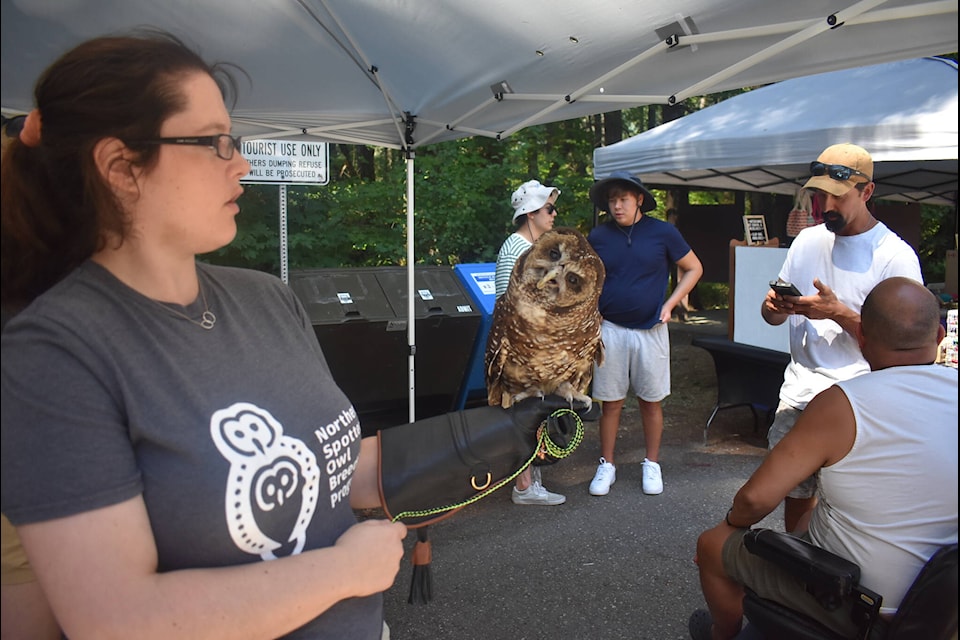It’s an exciting, hopeful, moment for B.C.’s wild spotted owls after a second release brings their population from one to three.
Two male spotted owls, named ‘sítist’ [te-syst] and ‘wíkcn’ [week-chin], were released on July 25 into the protected habitat in the Fraser Canyon. Their release is part of a partnership between the province’s Spotted Owl Breeding and Release Program and Spuzzum First Nation, to help recover the wild northern spotted owl populations in B.C.
“Supporting the recovery of threatened species in B.C. is a priority for my ministry,” said Nathan Cullen, Minister of Water, Land and Resource Stewardship. “That’s why we’re running the world’s only captive breeding and release program for northern spotted owls. Our strategy and the decisions we’re making to support spotted owl recovery are based on the best available science and Indigenous knowledge.”
In addition to the two male owls, one female — who was born in the wild — is also living in the Fraser Canyon.
According to the government, the two males were assessed “as healthy and ready to fend for themselves” prior to their release. This includes showing that they could catch live prey and maintain a stable body weight.
This is the program’s second release of captive-bred spotted owls into the wild. Sítist was originally released in August 2022, with two other males, as part of the program’s first release. Unfortunately, he was later found injured near train tracks in the Fraser Canyon. After being rehabilitated by the Orphaned Wildlife Society, he was returned to the program’s breeding facility in Langley.
Later, in May of this year, ministry staff confirmed that the two other males had died from unknown causes.
“We have a dedicated team of experts that includes First Nations and ministry staff that are doing everything they can to help spotted owls recover. We are hopeful, but this is a long process with no guarantee of success,” Cullen said. “The first release helped us learn more about raising and releasing captive-bred birds into the wild and has informed our existing protocols and procedures for transporting, releasing and supporting released owls.
“We remain committed to doing everything we can to support the recovery of northern spotted owls and continue to learn from the released owls to support their species’ survival.”
The spotted owls, whose name in Spuzzum is Skelúle? (Northern Spotted Owl is the name given by settlers of Canada), are seen as important relatives of the First Nation community, whose “presence are indicative of the health of the environment.”
An assembled team — made up of representatives of Spuzzum, the B.C. government, biologists, and Northern Spotted Owl experts — worked together from the beginning of the project. It is the partnership’s goal to eventually release as many as 20 spotted owls per year.
Both releases, which are a significant step towards an eventual self-sustaining population in B.C., were carefully planned government-to-government processes that incorporated Indigenous knowledge and guidance. A detailed assessment of the birds’ readiness was also necessary for their important move, which would see their return to Spuzzum.
In the time leading up to the first release, the province worked with the First Nations in B.C. to protect more than 280,000 hectares of spotted owl habitat in the Cascade region under the Spotted Owl Management Plan — a territory that can support 250 owls.
Like before, Ministry staff are monitoring the owls’ progress and are prepared to step in to help ensure their best chance of survival. Spuzzum Nation land guardians and members are also providing support with their knowledge of the health and well-being of the land.
In hopes of supporting their population’s recovery, an old-growth logging ban was also extended for part of the Fraser Canyon (where the birds were released) for another two years. An emergency order was also being recommended, earlier this year by the federal government, to help protect the spotted owl and it’s habitat from further logging and other activity that could disrupt their population growth.
Due to the need to safeguard these owls from any outside disturbance, both the media and the general public are not allowed access to the release site until further notice.
READ MORE: Death of 2 Northern Spotted Owls brings population in B.C. wilderness down to 1
@KemoneMoodley
kemone.moodley@hopestandard.com
Like us on Facebook and follow us on Twitter.
